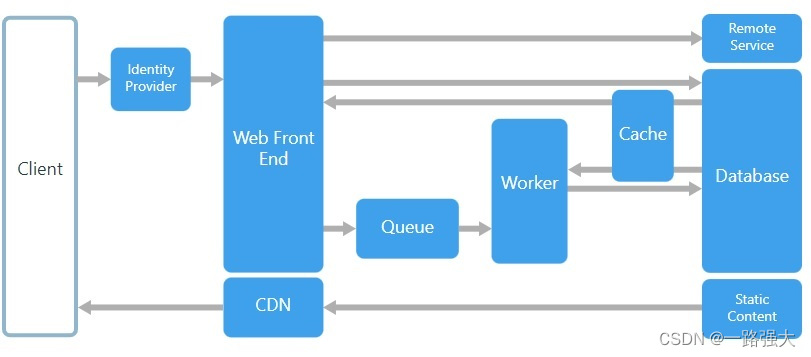在一种Web与消息的App设计中,有如下的概念
Web-Queue-Worker
For a purely PaaS solution, consider a Web-Queue-Worker architecture. In this style, the application has a web front end that handles HTTP requests and a back-end worker that performs CPU-intensive tasks or long-running operations. The front end communicates to the worker through an asynchronous message queue.
Web-queue-worker is suitable for relatively simple domains with some resource-intensive tasks. Like N-tier, the architecture is easy to understand. The use of managed services simplifies deployment and operations. But with complex domains, it can be hard to manage dependencies. The front end and the worker can easily become large, monolithic components that are hard to maintain and update. As with N-tier, this can reduce the frequency of updates and limit innovation.

其中有别于N-tier的一种情况,其中出现了通过用Queue或者event“消息”来进行前后端的传递处理。
那为什么要用消息呢?
考虑如下的场景
What can I use event streaming for?
Event streaming is applied to a wide variety of use cases across a plethora of industries and organizations. Its many examples include:
- To process payments and financial transactions in real-time, such as in stock exchanges, banks, and insurances.
- To track and monitor cars, trucks, fleets, and shipments in real-time, such as in logistics and the automotive industry.
- To continuously capture and analyze sensor data from IoT devices or other equipment, such as in factories and wind parks.
- To collect and immediately react to customer interactions and orders, such as in retail, the hotel and travel industry, and mobile applications.
- To monitor patients in hospital care and predict changes in condition to ensure timely treatment in emergencies.
- To connect, store, and make available data produced by different divisions of a company.
- To serve as the foundation for data platforms, event-driven architectures, and microservices.
所以,根据Apache Kafka的解释, 信息是种由生产方,存储方,和消费方共同完成的的对信息的产生,收集,和处理的过程。从而将前后端服务联系起来。是种轻量的方式
Event streaming is the digital equivalent of the human body's central nervous system. It is the technological foundation for the 'always-on' world where businesses are increasingly software-defined and automated, and where the user of software is more software.
Technically speaking, event streaming is the practice of capturing data in real-time from event sources like databases, sensors, mobile devices, cloud services, and software applications in the form of streams of events; storing these event streams durably for later retrieval; manipulating, processing, and reacting to the event streams in real-time as well as retrospectively; and routing the event streams to different destination technologies as needed. Event streaming thus ensures a continuous flow and interpretation of data so that the right information is at the right place, at the right time.
Apache Kafka® is an event streaming platform. What does that mean?
Kafka combines three key capabilities so you can implement your use cases for event streaming end-to-end with a single battle-tested solution:
- To publish (write) and subscribe to (read) streams of events, including continuous import/export of your data from other systems.
- To store streams of events durably and reliably for as long as you want.
- To process streams of events as they occur or retrospectively.
And all this functionality is provided in a distributed, highly scalable, elastic, fault-tolerant, and secure manner. Kafka can be deployed on bare-metal hardware, virtual machines, and containers, and on-premises as well as in the cloud. You can choose between self-managing your Kafka environments and using fully managed services offered by a variety of vendors.
其中的概念及组成
An event records the fact that "something happened" in the world or in your business. It is also called record or message in the documentation. When you read or write data to Kafka, you do this in the form of events. Conceptually, an event has a key, value, timestamp, and optional metadata headers. Here's an example event:
- Event key: "Alice"
- Event value: "Made a payment of $200 to Bob"
- Event timestamp: "Jun. 25, 2020 at 2:06 p.m."
Producers are those client applications that publish (write) events to Kafka, and consumers are those that subscribe to (read and process) these events. In Kafka, producers and consumers are fully decoupled and agnostic of each other, which is a key design element to achieve the high scalability that Kafka is known for. For example, producers never need to wait for consumers. Kafka provides various guarantees such as the ability to process events exactly-once.
Events are organized and durably stored in topics. Very simplified, a topic is similar to a folder in a filesystem, and the events are the files in that folder. An example topic name could be "payments". Topics in Kafka are always multi-producer and multi-subscriber: a topic can have zero, one, or many producers that write events to it, as well as zero, one, or many consumers that subscribe to these events. Events in a topic can be read as often as needed—unlike traditional messaging systems, events are not deleted after consumption. Instead, you define for how long Kafka should retain your events through a per-topic configuration setting, after which old events will be discarded. Kafka's performance is effectively constant with respect to data size, so storing data for a long time is perfectly fine.
Topics are partitioned, meaning a topic is spread over a number of "buckets" located on different Kafka brokers. This distributed placement of your data is very important for scalability because it allows client applications to both read and write the data from/to many brokers at the same time. When a new event is published to a topic, it is actually appended to one of the topic's partitions. Events with the same event key (e.g., a customer or vehicle ID) are written to the same partition, and Kafka guarantees that any consumer of a given topic-partition will always read that partition's events in exactly the same order as they were written.

























 3070
3070











 被折叠的 条评论
为什么被折叠?
被折叠的 条评论
为什么被折叠?








